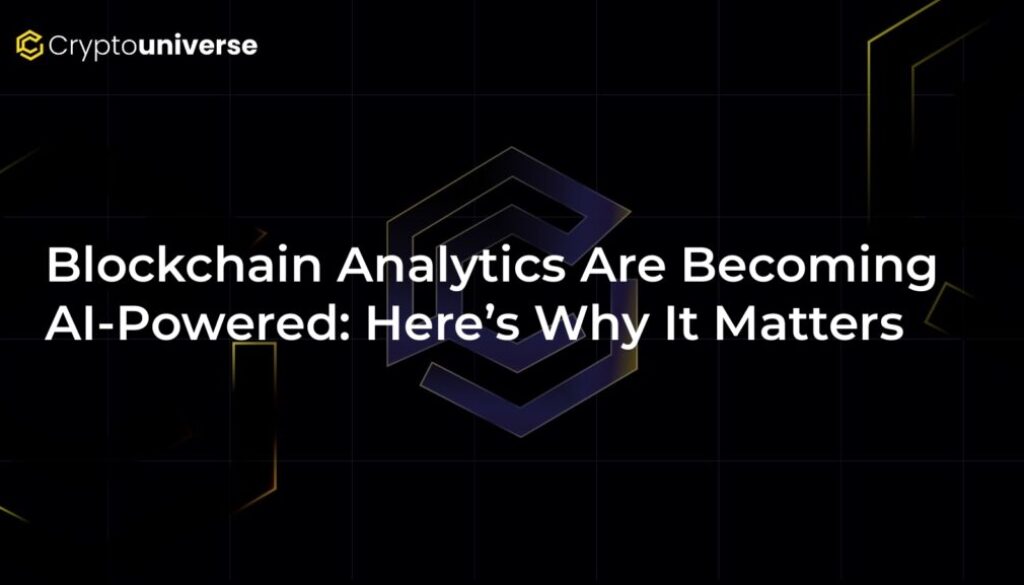Blockchain Analytics Are Becoming AI-Powered: Here’s Why It Matters

The Promise and Problem of Blockchain Transparency
The world of blockchain has always been built on a foundation of radical transparency. Every single transaction, from a multi-million dollar institutional trade to a simple NFT purchase, is recorded on an immutable public ledger. In theory, this opens the door to an unprecedented level of clarity and accountability. In practice, however, it’s a bit more complicated.
With billions of transactions flowing through millions of wallet addresses, the sheer volume of data is overwhelming. For the average person, and even for seasoned analysts, looking at raw on-chain data is like trying to find a specific grain of sand on an endless beach. This is where blockchain analytics tools have traditionally stepped in, acting as a metal detector to help find the valuable needles in the digital haystack.
But now, a powerful new force is upgrading that metal detector to a super-magnet: Artificial Intelligence. The fact that
From Complex Dashboards to Simple Questions
For years, blockchain analytics platforms have provided immense value. They label wallets belonging to exchanges, venture capitalists, and even hackers, allowing users to trace the flow of funds. This has been crucial in everything from tracking down stolen assets in major hacks to providing vital context during industry-shaking events like the collapse of FTX.
For traders and investors, these tools offer an edge by revealing:
- Whale Movements: Tracking what the largest holders are buying or selling.
- Smart Money: Following wallets with a proven track record of profitable trades.
- Token Flows: Seeing if capital is moving into or out of a specific cryptocurrency or DeFi protocol.
The problem? A steep learning curve. Navigating complex dashboards, understanding esoteric metrics, and piecing together data points has largely remained the domain of dedicated analysts and data scientists. The real challenge has always been usability.
Enter AI: The Great Democratizer of On-Chain Data
The integration of Artificial Intelligence, particularly Natural Language Processing (NLP), is tearing down these barriers to entry. Instead of needing to be a data wizard, users can now ask simple, direct questions in plain English.
Imagine being able to query the blockchain by asking:
- “Show me the top 10 wallets that bought PEPE before it was listed on Binance.”
- “Which DeFi protocols have seen the largest inflow of stablecoins this week?”
- “Are there any suspicious transaction patterns related to this new token launch?”
This is precisely what new AI-powered analytics tools are beginning to offer. By translating human language into complex data queries, AI makes sophisticated on-chain intelligence accessible to retail investors, compliance officers, journalists, and curious enthusiasts alike.
Why AI-Powered Analytics Matter for Everyone
This evolution is more than just a convenience; it has profound implications for the entire crypto ecosystem.
For Investors and Traders
AI doesn’t just simplify queries; it supercharges analysis. Machine learning algorithms can detect subtle patterns of accumulation or distribution that might be invisible to the human eye. They can flag potential wash trading, identify coordinated wallet activity, and even provide predictive insights into market movements, giving traders a more powerful toolkit than ever before.
For Security and Law Enforcement
Following the money is the cornerstone of financial investigation. AI enhances this capability exponentially. It can help authorities untangle complex webs of illicit transactions, identify hacking syndicates by their on-chain fingerprints, and track stolen funds in near real-time across multiple blockchains, making the crypto space safer for everyone.
For DeFi Protocols and dApps
For developers and project teams, AI-driven analytics can serve as a real-time health monitor. It can help identify potential economic exploits, understand user behavior in depth, and ensure the long-term sustainability and security of their protocols.
The Future is Transparent and Intelligent
The promise of blockchain was never just about recording data; it was about making that data meaningful and empowering. For a long time, the complexity of that data has been a major hurdle. Now, AI is bridging the gap between raw information and actionable insight.
As these tools become more sophisticated, we are moving toward a future where on-chain intelligence is not a niche skill but a common utility. This new era of clarity will foster greater accountability, smarter investing, and a more secure and accessible digital economy for all.


